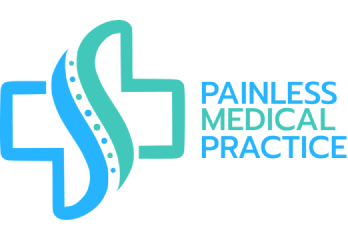Sciatica Pain Relief

What is Sciatica?
Sciatica is a pain that follows the path of the sciatic nerve, extending from the lower back through the hips, buttocks, and down each leg. This pain often arises when a herniated disk, bone spur, or spinal stenosis puts pressure on the nerve, leading to inflammation, pain, and occasionally numbness in the leg. Typically, sciatica affects one side of the body, with pain levels varying from mild to intense.
What Causes Sciatica?
- Herniated or slipped disk that presses on the sciatic nerve.
- Spinal stenosis, a narrowing of the spinal canal in the lower back.
- Degenerative disc disease, where the discs between vertebrae break down over time.
- Spondylolisthesis, where a vertebra slips forward over the one below it.
- Piriformis syndrome is when the piriformis muscle compresses the sciatic nerve.
- Trauma to the lower spine or buttocks can compress the sciatic nerve, causing pain.
- Bone spurs pressing on the nerve roots in the lumbar spine.
- Prolonged sitting or a sedentary lifestyle can compress the sciatic nerve and cause sciatica.
Sciatica Symptoms
- Intense, shooting pain that travels from the lower back down into the leg.
- Numbness or tingling sensations in the leg or foot.
- Burning or electric shock-like pain along the sciatic nerve path.
- Weakness in the affected leg or foot.
- Difficulty standing up or walking due to leg pain.
- Pain that worsens when sitting for long periods.
- Pain that intensifies with movements like bending, twisting, or coughing.
- Pain that radiates to the hip or buttock can also be a symptom of sciatica.
How is Sciatica Diagnosed?
Diagnosing sciatica typically includes a combination of a medical history review, a physical exam, and imaging tests. During the physical exam, a doctor may check your muscle strength and reflexes, asking you to perform movements like walking on your toes or lifting your legs.
For persistent or severe symptoms, imaging tests like X-rays, MRIs, or CT scans might be used to identify issues like herniated disks or spinal stenosis that could be compressing the existing nerve roots and cause sciatic nerve pain. Electromyography (EMG) and nerve conduction studies can help assess nerve function and pinpoint the specific location of nerve compression.


Treatment Options for Sciatica Pain Relief
Finding effective sciatica pain relief can greatly improve your quality of life, especially when pain disrupts daily activities. Several sciatica treatment options are available, ranging from at-home care to medical procedures, depending on the severity of your symptoms. The right sciatica treatment can help reduce pain and inflammation, improve mobility, and prevent future flare-ups. Understanding these options is key to finding effective sciatica pain relief.
Medications
Medications are a very important part of sciatic nerve pain relief and can help manage pain and inflammation. Over-the-counter options like NSAIDs (ibuprofen or naproxen) are often the first step for sciatic nerve pain relief, reducing swelling and discomfort. For more severe pain, doctors may prescribe muscle relaxants, oral steroids, or stronger pain relievers like opioids. In some cases, sciatica therapies may include anti-seizure medications or antidepressants, which can help ease nerve-related pain. Medications are often combined with other treatments, such as physical therapy.
Physical Therapy
Physical therapy for sciatica focuses on reducing pain, improving mobility, and strengthening the muscles that support the spine. A therapist will design a personalized plan that includes targeted stretches and exercises to ease pressure on the sciatic nerve. These movements help increase flexibility and improve posture, which can prevent future flare-ups. Sciatica supportive therapy often involves core strengthening exercises, which provide extra stability and reduce strain on the lower back. This sciatica pain treatment aims for long-term relief.
Steroid Injections
Steroid injections are a sciatica medical procedure that delivers corticosteroids directly into the area around the irritated nerve roots. This treatment helps relieve sciatica pain by reducing inflammation, which can ease pressure on the sciatic nerve. It is often used when other treatments haven’t provided sufficient relief. Steroid injections can offer immediate relief for sciatica pain, and the effects may last from a few weeks to a few months. The procedure is typically guided by X-ray for accurate placement. It is a minimally invasive option that can help boost mobility and reduce discomfort.
Surgery
Sciatic nerve surgery is considered when other treatments for sciatic nerve pain fail to provide relief, or when symptoms are severe, such as significant weakness, loss of bowel or bladder control, or debilitating pain. The two common surgical options include microdiscectomy, which removes part of a herniated disc pressing on the sciatic nerve, and laminectomy-foraminatomy, where a portion of bone pressing on the nerve is removed. These procedures aim at treating sciatica by directly addressing the nerve compression, offering more permanent relief compared to non-surgical methods. Recovery often involves physical therapy.
Conditions We Treat
- Headaches
- Chronic Headaches
- Migraine
- Arthritis
- Sciatica
- Back Pain
- Neck Pain

- Knees Pain
- Post-Surgical Pain
- Hips Pain
- Joints Pain
- Muscle Pain
- Neuropathic Pain

When to See a Doctor for Sciatica?
It’s important to see a doctor for sciatica if you experience severe or persistent pain that doesn’t improve with self-care measures after a few weeks. Seek medical help if you notice significant weakness, numbness, or difficulty moving your leg or foot. Immediate attention is also needed if relieving sciatic pain at home fails or if you lose control of your bladder or bowels, as this may indicate a serious condition like cauda equina syndrome. Consulting a doctor early can help prevent further nerve damage and provide effective treatment.
for your pain needs
Choose Us for Sciatica Pain Relief in Chicago, IL
For sciatica pain relief in Chicago, choose Painless Medical Practice, led by Dr. Jaroslav Tymouch. As a top pain management clinic, we offer fully personalized treatments to target sciatica at its source. Our advanced methods include shockwave therapy, X-ray guided injections for the neck, thoracic, and lower back, as well as medial branch blocks and epidural injections.
We combine these with medications, physical therapy, and modern therapies like stemwave and laser therapy, specialized injections and medications all to deliver effective sciatica pain treatment. Contact us today to start yourway to effective sciatica nerve relief and a long-awaited pain-free life!

Our Insurance Partners









FAQs About Sciatica Pain Relief
How to Treat Sciatica?
Sciatica can be treated through a combination of self-care, physical therapy, medications, and, in some cases, injections or surgery. Initial treatment often includes rest, over-the-counter pain relievers, applying heat or cold, and gentle stretches. If the pain persists, a doctor may recommend physical therapy, steroid injections, or other interventions.
Where to Go for Sciatica Treatment?
For sciatica treatment, you can visit a primary care physician, a pain management specialist, a physical therapist, or a spine specialist. Pain management clinics, like Painless Medical Practice, often provide comprehensive care with access to a range of treatment options, including non-surgical and advanced therapies.
Where is Sciatica Pain?
Sciatica pain typically starts in the lower back or buttock and radiates down one leg. The pain may follow the path of the sciatic nerve, which runs through the hips, buttocks, and down the back of the leg to the foot. It can vary from mild discomfort to sharp, burning pain.
What Doctors Treat Sciatica?
Sciatica can be treated by several types of doctors, including primary care physicians, neurologists, orthopedic specialists, pain management specialists, and physical therapists. For more severe cases, a spine surgeon may be consulted.
When Should I See a Doctor for Sciatica?
You should see a doctor if your sciatica pain lasts longer than a few weeks, worsens, or if it is accompanied by severe symptoms like numbness, muscle weakness, or loss of bladder or bowel control. Immediate medical attention is needed if these symptoms occur.
How Long Does Sciatica Pain Last?
The duration of sciatica pain can vary widely. For some, it may resolve within a few days to weeks with conservative treatment, while for others, it may become a chronic issue lasting several months. The underlying cause of the pain plays a big role in how long it persists.
What People Say About Us
our services before

